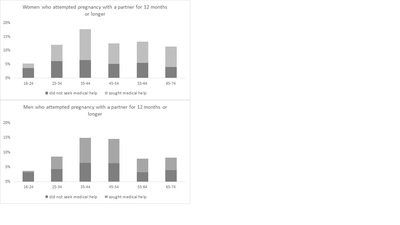Datta, J;
Palmer, MJ;
Tanton, C;
Gibson, LJ;
Jones, KG;
Macdowall, W;
Glasier, A;
... Wellings, K; + view all
(2016)
Prevalence of infertility and help seeking among 15 000 women and men.
Human Reproduction
, 31
(9)
pp. 2108-2118.
10.1093/humrep/dew123.

Preview |
Text
tanton_Hum. Reprod.-2016-Datta-2108-18.pdf Download (394kB) | Preview |
Preview |
Text
tanton_Infertility paper tables amended.pdf Download (768kB) | Preview |
![[thumbnail of tanton_Infertility paper Figure 1.jpg]](https://discovery-pp.ucl.ac.uk/1504647/3.hassmallThumbnailVersion/tanton_Infertility%20paper%20Figure%201.jpg)  Preview |
Image
tanton_Infertility paper Figure 1.jpg Download (51kB) | Preview |
Abstract
STUDY QUESTION: What is the prevalence of infertility and of help seeking among women and men in Britain? SUMMARY ANSWER: One in eight women and one in ten men aged 16-74 years had experienced infertility, defined by unsuccessfully attempting pregnancy for a year or longer, and little more than half of these people sought medical or professional help. WHAT IS KNOWN ALREADY: Estimates of infertility and help seeking in Britain vary widely and are not easily comparable because of different definitions and study populations. STUDY DESIGN, SIZE, DURATION: A cross-sectional population survey was conducted between 2010 and 2012 with a sample of 15 162 women and men aged 16-74 years. PARTICIPANTS/MATERIALS, SETTING, METHODS: Participants completed the Natsal-3 questionnaire, using computer-assisted personal interviewing (CAPI) and computer-assisted self-interview (CASI). MAIN RESULTS AND THE ROLE OF CHANCE: The reported prevalence of infertility was 12.5% (CI 95% 11.7-13.3) among women and 10.1% (CI 95% 9.2-11.1) among men. Increased prevalence was associated with later cohabitation with a partner, higher socio-economic status and, for those who had a child, becoming parents at older ages. The reported prevalence of help seeking was 57.3% (CI 95% 53.6-61.0) among women and 53.2% (CI 95% 48.1-58.1) among men. Help seekers were more likely to be better educated and in higher status occupations and, among those who had a child, to have become parents later in life. LIMITATIONS, REASONS FOR CAUTION: These data are cross-sectional so it is not possible to establish temporality or infer causality. Self-reported data may be subject to recall bias. WIDER IMPLICATIONS OF THE FINDINGS: The study provides estimates of infertility and help seeking in Britain and the results indicate that the prevalence of infertility is higher among those delaying parenthood. Those with higher educational qualifications and occupational status are more likely to consult with medical professionals for fertility problems than others and these inequalities in help seeking should be considered by clinical practice and public health.
| Type: | Article |
|---|---|
| Title: | Prevalence of infertility and help seeking among 15 000 women and men |
| Open access status: | An open access version is available from UCL Discovery |
| DOI: | 10.1093/humrep/dew123 |
| Publisher version: | http://doi.org/10.1093/humrep/dew123 |
| Language: | English |
| Additional information: | © The Author 2016. Published by Oxford University Press on behalf of the European Society of Human Reproduction and Embryology. This is an Open Access article distributed under the terms of the Creative Commons Attribution License (http://creativecommons.org/licenses/by/4.0/), which permits unrestricted reuse, distribution, and reproduction in any medium, provided the original work is properly cited. |
| Keywords: | Female infertility, help seeking, infertility, male infertility, population survey |
| UCL classification: | UCL UCL > Provost and Vice Provost Offices > School of Life and Medical Sciences UCL > Provost and Vice Provost Offices > School of Life and Medical Sciences > Faculty of Population Health Sciences > Institute for Global Health UCL > Provost and Vice Provost Offices > School of Life and Medical Sciences > Faculty of Population Health Sciences > Institute for Global Health > Infection and Population Health |
| URI: | https://discovery-pp.ucl.ac.uk/id/eprint/1504647 |
Archive Staff Only
 |
View Item |


